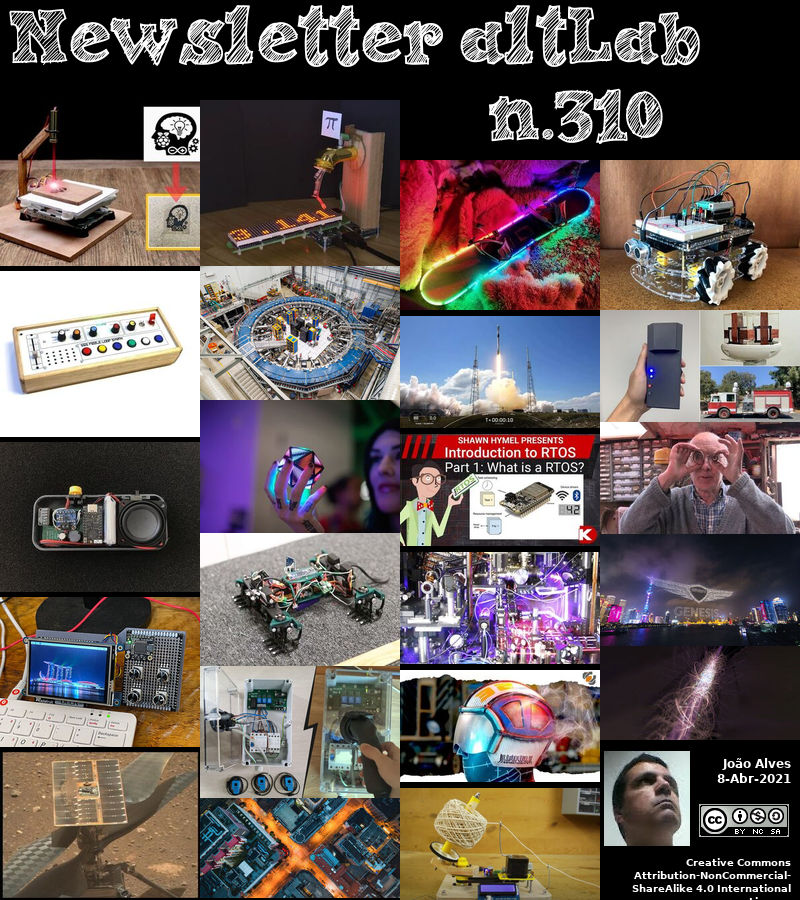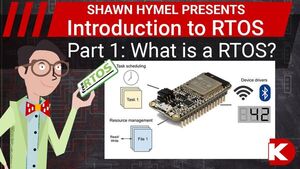2021-04-08 - Nº 310
Editorial
Esta é a Newsletter Nº 310 que se apresenta com o mesmo formato que as anteriores. Se gostar da Newsletter partilhe-a!
Todas as Newsletters encontram-se indexadas no link.
Esta Newsletter tem os seguintes tópicos:
Faz hoje anos que nascia, em 1732, o astrónomo e matemático norte-americano David Rittenhouse. Ele foi um dos primeiros observadores da atmosfera de Vénus. Para observações do trânsito de Vénus em 3 de Junho de 1769, ele construiu um relógio de pêndulo de alta precisão, um quadrante astronómico, um instrumento de igual altitude e um trânsito astronómico. Ele foi o primeiro na América a colocar teias de aranha como mira no foco de seu telescópio. Ele geralmente é creditado com a invenção da bússola vernier e, possivelmente, o levantador automático de agulha. Ele foi professor de astronomia na Universidade da Pensilvânia. Para Thomas Jefferson, ele padronizou as medidas do pé por pêndulo num projecto para estabelecer um sistema decimal de pesos e medidas.
Faz também hoje anos que nascia, em 1779, o Físico alemão Johann Schweigger. Ele inventou o galvanometro em 1820, um dispositivo para medir a força de uma corrente eléctrica. Ele desenvolveu o princípio a partir da experiência de Oersted (1819), que mostrou que a corrente num fio desvia a agulha de uma bússola. Schweigger percebeu que sugeria um instrumento de medição básico, já que uma corrente mais forte produziria uma deflexão maior, e ele aumentou o efeito enrolando o fio várias vezes numa bobine à volta da agulha magnética. Ele chamou a este instrumento de “galvanometro” em homenagem a Luigi Galvani, o professor que deu a Volta a ideia da primeira bateria. Thomas Seebeck (1770-1831) chamou a bobine inovadora de multiplicador de Schweigger. Tornou-se a base dos instrumentos de bobine em movimento e alto-falantes.
Faz igualmente hoje anos que nascia, em 1811, o metalúrgico inglês Robert Forester Mushet. Ele foi responsável pelo desenvolvimento de um método de fabricação de aço pela adição de manganês, que melhorou o processo Bessemer. Ele foi o primeiro a fazer carris duráveis de aço (substituindo o ferro fundido), o que foi importante para o desenvolvimento das ferro-vias em todo o mundo. Mushet inventou o aço de tungsténio em 1868, que produzia um aço para ferramentas mais resistente, capaz de cortar e maquinar metais mais duros em velocidades mais rápidas. Apesar da sua importância, que fez fortuna para outros (incluindo Bessemer), Mushet não capitalizou com sucesso suas descobertas.
Faz também hoje anos que nascia, em 1818, o químico alemão August Wilhelm von Hofmann. Ele, com as pesquisas sobre anilina, com a de seu ex-aluno Sir William Henry Perkin, ajudaram a estabelecer as bases da indústria de corantes de anilina. Ele foi o primeiro a preparar a rosanilina e seus derivados e pesquisou muitos outros compostos, incluindo a descoberta do formaldeído. No campo da química orgânica, Hofmann é mais conhecido por seus estudos dos derivados orgânicos da amónia e da fosfina e por sua subsequente descoberta da reacção de degradação de Hofmann. Ele também desenvolveu o método de Hofmann para encontrar as densidades de vapor e, a partir delas, os pesos moleculares dos líquidos. Ele também ajudou a popularizar o conceito de valência (a palavra vem de seu termo quantivalência).
Por fim, faz hoje anos que nascia, em 1911,o bioquímico norte-americano Melvin Calvin. Ele recebeu o Prémio Nobel de Química em 1961 por promover nosso conhecimento do mecanismo da fotossíntese. No Ciclo de Calvin, ele descreveu as “reacções escuras” da fotossíntese que ocorrem nas plantas verdes durante a noite, transformando dióxido de carbono em açúcar. Usando o isótopo de carbono-14 como traçador de dióxido de carbono, Calvin e sua equipa identificaram a rota completa conforme o átomo de carbono viaja por uma planta durante a fotossíntese, desde a absorção do dióxido de carbono atmosférico até à sua incorporação em carbo-hidratos e outros compostos orgânicos. Com o seu grupo, Calvin mostrou que a luz do sol actua sobre as moléculas de clorofila de uma planta, e não sobre o dióxido de carbono (como se acreditava anteriormente).
Faz hoje precisamente 5 anos que a SpaceX fez com sucesso o primeiro pouso de retorno suave de um foguetão booster Falcon 9 reutilizável num navio drone no mar. A SpaceX, uma empresa privada de voos espaciais, realizou assim uma façanha nunca antes realizada por ninguém. Foi o primeiro estágio do foguete Falcon 9 que também lançou com sucesso uma cápsula de carga para a Estação Espacial Internacional. Depois de içar o segundo estágio (que continuou no espaço), o estágio de reforço foi projectado para se separar e retornar intacto para ser usado novamente. Ele disparou propulsores para reduzir a velocidade e para orientar e fazer um pouso vertical na barcaça.
Nesta semana que passou o helicóptero Mars Ingenuity destravou as suas duas pás do rotor enquanto os preparativos continuam para o primeiro voo do veículo, que deve ocorrer no máximo neste domingo. O drone chegou a Marte a 18 de Fevereiro junto com o rover Perseverance da NASA, tendo feito a longa jornada até o Planeta Vermelho dentro do rover. A 4 de Abril, o pequeno drone separou-se do Perseverance, preparando-se para subir aos céus durante uma campanha de teste de um mês. Se a saída de domingo do Ingenuity for bem-sucedida, será o primeiro voo guiado com motor noutro planeta.
Também nesta semana que passou um foguetão Falcon 9 da SpaceX lançou um novo lote de 60 satélites da Internet Starlink em órbita na tarde de quarta-feira e pousou no mar terminando mais uma missão bem-sucedida. O foguetão deste lançamento, chamado B1058, é um dos foguetões comprovados em voo da frota da SpaceX. Ele tem agora tem sete lançamentos e pousos no seu currículo e está rapidamente a destacar-se como um dos líderes da frota.
Na Newsletter desta semana apresentamos diversas noticias, artigos científicos, projetos de maker assim como alguns videos interessantes.
 João Alves ([email protected])
João Alves ([email protected])
O conteúdo da Newsletter encontra-se sob a licença  Creative Commons Attribution-NonCommercial-ShareAlike 4.0 International License.
Creative Commons Attribution-NonCommercial-ShareAlike 4.0 International License.
Novidades da Semana

Mars helicopter Ingenuity unlocks its rotor blades to prepare for 1st flight on Red Planet
"The Mars helicopter Ingenuity has unlocked its two rotor blades as preparations continue for the vehicle's first flight, due to occur no earlier than Sunday (April 11). Ingenuity arrived on Mars Feb. 18 along with NASA's Perseverance rover, having made the long trek out to the Red Planet tucked inside the rover's belly. As of April 4, the little chopper has parted ways with Perseverance, preparing to take to the skies during a month-long test campaign. If Ingenuity's Sunday sortie is successful, it will be the first powered, guided flight on another planet. "The blades of glory, aka rotor blades of the #MarsHelicopter, have been unlocked and are ready for testing," NASA's Jet Propulsion Laboratory (JPL) in California wrote in a tweet posted early today (April 8). "Next, we'll do a slow-speed spin-up of the blades for the first time on the Martian surface."" [...]

SpaceX launches another 60 Starlink satellites into orbit and sticks rocket landing
"A SpaceX Falcon 9 rocket launched a new batch of 60 Starlink internet satellites into orbit on Wednesday afternoon (April 7) and nailed a landing at sea to top off a successful mission. The veteran Falcon 9 rocket blasted off from Space Launch Complex 40 here at Cape Canaveral Space Force Station in Florida at 12:34 p.m. EDT (1634 GMT), marking the company's 10th launch of the year. "Falcon 9 has successfully lifted off from Cape Canaveral Space Force Station carrying our stack of Starlink satellites to orbit," Jessie Anderson, a SpaceX manufacturing engineer, said during a live webcast of the launch. Approximately nine minutes later, the rocket's first stage returned to Earth, touching down on SpaceX's drone ship "Of Course I Still Love You," for its seventh successful landing. SpaceX is continuing the rapid launch pace set last year, as the Hawthorne, California-based rocket builder celebrated its 10th launch so far in 2021. The majority of those launches have been SpaceX's own Starlink satellites, as the company inches closer to filling its initial internet constellation of 1,440 broadband satellites." [...]
Outras Notícias

New Intel Processors Accelerate 5G Network Transformation
"Intel today launched its newest 3rd Gen Intel® Xeon® Scalable processor (code-named “Ice Lake”), including new network-optimized “N-SKUs” along with verified solution blueprints that accelerate time to market. New “N-SKUs” deliver an average 62% more performance1 on a range of broadly deployed 5G and network workloads over the prior generation. Intel also announced it has started sampling next-generation Intel® Xeon® D processors designed for space and power-constrained environments at the edge. “We are further unleashing the capabilities of 5G and the power of the intelligent edge with our latest network-optimized 3rd Gen Intel Xeon Scalable processors. Designed to support diverse network environments, our newest 3rd Gen processors and platform ingredients enable global communications service providers to deliver the next breakthrough in network innovation for even richer consumer and enterprise use cases.” –Dan Rodriguez, Intel corporate vice president and general manager, Network Platforms Group Why They Matter: With the buildout of 5G and the rise of the intelligent edge, network infrastructure and technology need to evolve. As the leading provider of network silicon, Intel delivers the most complete set of network technologies to transform the network, and fosters the broadest, most proven ecosystem so customers have more choices and can accelerate time to deployment." [...]
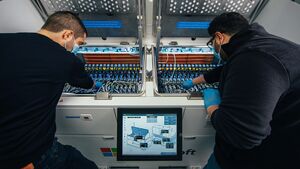
To cool datacenter servers, Microsoft turns to boiling liquid
"Emails and other communications sent between Microsoft employees are literally making liquid boil inside a steel holding tank packed with computer servers at this datacenter on the eastern bank of the Columbia River. Unlike water, the fluid inside the couch-shaped tank is harmless to electronic equipment and engineered to boil at 122 degrees Fahrenheit, 90 degrees lower than the boiling point of water. The boiling effect, which is generated by the work the servers are doing, carries heat away from laboring computer processors. The low-temperature boil enables the servers to operate continuously at full power without risk of failure due to overheating. Inside the tank, the vapor rising from the boiling fluid contacts a cooled condenser in the tank lid, which causes the vapor to change to liquid and rain back onto the immersed servers, creating a closed loop cooling system. “We are the first cloud provider that is running two-phase immersion cooling in a production environment,” said Husam Alissa, a principal hardware engineer on Microsoft’s team for datacenter advanced development in Redmond, Washington." [...]

Integrated 1.5A Synchronous Regulators from STMicroelectronics Simplify High-Efficiency Power Conversion
"STMicroelectronics has introduced L6981 synchronous step-down regulators, extending the family of high-efficiency converters that simplify power-supply design by integrating power elements, feedback circuitry, and safety features on-chip. Rated to deliver up to 1.5A, with 90% typical efficiency at full load, the L6981 converters are available in two variants optimized for light-load efficiency and noise performance. The L6981C for low-current operation uses pulse skipping to maximize efficiency at light loads extending the runtime of battery-powered devices. The L6981N prioritizes low noise by operating permanently in PWM (pulse-width modulation) mode at constant switching frequency and minimizing voltage ripple at light loads. Both variants can accept an input voltage from 3.5V to 38V, making them well suited to use in 24V industrial bus-powered applications, 12V and 24V battery-powered equipment, HVAC power supplies, decentralized intelligent nodes, smart sensors, and always-on applications. The output voltage can be adjusted from 0.85V up to the input-voltage value using external resistors." [...]

AMD and Xilinx Stockholders Overwhelmingly Approve AMD’s Acquisition of Xilinx
"AMD (NASDAQ:AMD) and Xilinx, Inc. (NASDAQ:XLNX) announced today that stockholders voted to approve their respective proposals relating to the pending acquisition of Xilinx by AMD. The acquisition will bring together two industry leaders with complementary product portfolios and customers, combining CPUs, GPUs, FPGAs, Adaptive SoCs and deep software expertise to enable leadership in computing platforms for cloud, edge and end devices. Together, the combined company will have the ability to capitalize on opportunities spanning some of the industry’s most important growth segments, including data centers, gaming, PCs, communications, automotive, industrial, aerospace and defense. “For several years, AMD has successfully executed our long-term growth strategy and deepened the company’s partnerships to drive high performance computing leadership,” said Dr. Lisa Su, AMD president and CEO. “The acquisition of Xilinx marks the next leg in our journey to make AMD the strategic partner of choice for the largest and most important technology companies in the world as an industry leader with the vision, talent and scale to support their future innovation.” “The Xilinx team is one of the strongest in the industry and we are thrilled to be joining AMD,” said Victor Peng, Xilinx president and CEO. “Our shared cultures of innovation, excellence and collaboration will enable us to accelerate growth in the data center and pursue a broader customer base across more markets as a combined company.” The closing of the transaction remains subject to the satisfaction of other customary closing conditions, including the receipt of required regulatory approvals." [...]

Renesas Launches RX23W Module with Bluetooth for System Control and Wireless Communication on IoT Devices
"New Radio Law-Certified Bluetooth Module Combines RX23W MCU, Antenna, and Peripheral Circuits in an Industry-leading Small Package Renesas Electronics Corporation (TSE:6723), a premier supplier of advanced semiconductor solutions, today introduced the RX23W Module with full Bluetooth® 5.0 Low Energy support for system control and wireless communication on IoT endpoint devices. Featuring the RX23W 32-bit RX MCU supporting fully integrated Bluetooth Low Energy communication, the new RX23W module is equipped with an antenna, oscillator and custom-matched circuit. The new module is certified under Radio Law for multiple countries, including Japan and the United States (Note), and is Bluetooth SIG certified. This eliminates the need for additional RF design work, tuning, or specialized RF knowledge, allowing customers to use the module as it is, shortening new product development time. The very small 6.1 mm x 9.5 mm, 83-pin LGA package makes it possible to design more compact devices with fewer external components, reducing the bill of materials (BOM) cost. This improves the development efficiency of IoT endpoint devices such as home appliance, healthcare and sports and fitness equipment." [...]

Industry's first DC/DC controllers with an integrated active EMI filter enable engineers to achieve the smallest low-EMI power designs
"Texas Instruments (TI) (Nasdaq: TXN) today introduced a new family of synchronous DC/DC buck controllers that enable engineers to shrink the size of the power-supply solution and lower its electromagnetic interference (EMI). Featuring an integrated active EMI filter (AEF) and dual-random spread-spectrum (DRSS) technology, the LM25149-Q1 and LM25149 enable engineers to cut the area of the external EMI filter in half, lower the conducted EMI of the power design by as much as 55 dBµV across multiple frequency bands, or achieve a combination of reduced filter size and low EMI. For more information, see www.ti.com/LM25149-Q1-pr and www.ti.com/LM25149-pr. Reducing EMI in the power supply is a growing design challenge, especially as electronic content increases in advanced driver assistance systems (ADAS), automotive infotainment and cluster, building automation, and aerospace and defense designs. A traditional way to ensure that a design meets conducted EMI specifications involves increasing the size of the external passive EMI filter, which in turn increases the overall power supply solution size. By integrating the AEF, the LM25149-Q1 and LM25149 buck controllers enable engineers to meet EMI standards while increasing their design’s power density." [...]

Genesis Celebrates Launch In China With Dazzling, World Record-breaking Drone Show Over Shanghai’s Iconic Skyline
"Genesis marked its arrival in China with an extraordinary visual debut, presenting a progressive new form of brand storytelling to Chinese audiences With the skies of central Shanghai as its canvas, Genesis employed thousands of illuminated drones to paint an evocative picture of its brand identity and distinctive design philosophy 3,281 drones were mobilized at the peak of the performance, setting a new Guinness World Record and demonstrating Genesis’ spirit of always pushing the boundaries through technologically advanced experience Genesis stirred a sensation in Shanghai on March 29, lighting up the evening sky with thousands of drones in a stunning performance to celebrate the official entry of Genesis into the Chinese market. The spectacular visuals were coordinated to present the world of Genesis, delivering an audacious storytelling concept while also breaking the Guinness World Records for “The Most Unmanned Aerial Vehicles (UAVs) airborne simultaneously”. Markus Henne, Chief Executive Officer of Genesis Motor China, said, “At the heart of the Genesis promise is the daring spirit to do things differently. Our first-ever moment in China was a special opportunity to engage with our audience and show what Genesis is about. With this record-breaking drone performance, we brought our brand story and philosophy to life for many Chinese consumers. Soon, we will bring even more inspiring Genesis experiences and products to the consumers in China.” Set above the glittering skyscrapers of the iconic Shanghai skyline, the complex and innovative production was designed to showcase Genesis’s unique brand concept and design philosophy." [...]

Why Shortages of a $1 Chip Sparked Crisis in Global Economy
"To understand why the $450 billion semiconductor industry has lurched into crisis, a helpful place to start is a one-dollar part called a display driver. Hundreds of different kinds of chips make up the global silicon industry, with the flashiest ones from Qualcomm Inc. and Intel Corp. going for $100 apiece to more than $1,000. Those run powerful computers or the shiny smartphone in your pocket. A display driver chip is mundane by contrast: Its sole purpose is to convey basic instructions for illuminating the screen on your phone, monitor or navigation system. The trouble for the chip industry -- and increasingly companies beyond tech, like automakers -- is that there aren’t enough display drivers to go around. Firms that make them can’t keep up with surging demand so prices are spiking." [...]

Intel Launches Its Most Advanced Performance Data Center Platform
"Intel Showcases New 3rd Gen Intel Xeon Scalable – the Only x86 Data Center Processors with Built-In AI; Delivering on Average 46% Increased Performance New 3rd Gen Intel® Xeon® Scalable processors — combined with Intel’s portfolio of Intel® Optane™ persistent memory and storage, Ethernet adapters, FPGAs and optimized software solutions — deliver performance and workload optimizations across hybrid-cloud, high performance computing (HPC), networking and intelligent edge applications. New 3rd Gen Intel Xeon Scalable processors feature a flexible architecture with integrated artificial intelligence (AI) acceleration with Intel® DL Boost technology, plus advanced security capabilities to protect data and application code with Intel® Software Guard Extension (Intel® SGX) and Intel® Crypto Acceleration. New 3rd Gen Intel Xeon Scalable processors are rapidly ramping, having shipped more than 200,000 units for revenue in the first quarter of 2021 with broad industry adoption across all market segments, including the world’s top cloud service providers set to deploy services; more than 250 design wins within 50 unique OxM partners; more than 15 major telecom equipment manufacturers and communications service providers readying POCs and networking deployments; and over 20 HPC labs and HPC-as-a-service environments leveraging our latest Xeon Scalable processors. SANTA CLARA, Calif., April 6, 2021 – Intel today launched its most advanced, highest performance data center platform optimized to power the industry’s broadest range of workloads — from the cloud to the network to the intelligent edge. New 3rd Gen Intel Xeon Scalable processors (code-named “Ice Lake”) are the foundation of Intel’s data center platform, enabling customers to capitalize on some of the most significant business opportunities today by leveraging the power of AI. New 3rd Gen Intel Xeon Scalable processors deliver a significant performance increase compared with the prior generation, with an average 46% improvement on popular data center workloads.1 The processors also add new and enhanced platform capabilities including Intel SGX for built-in security, and Intel Crypto Acceleration and Intel DL Boost for AI acceleration." [...]

NASA’s Odyssey Orbiter Marks 20 Historic Years of Mapping Mars
"NASA’s 2001 Mars Odyssey spacecraft launched 20 years ago on April 7, making it the oldest spacecraft still working at the Red Planet. The orbiter, which takes its name from Arthur C. Clarke’s classic sci-fi novel “2001: A Space Odyssey” (Clarke blessed its use before launch), was sent to map the composition of the Martian surface, providing a window to the past so scientists could piece together how the planet evolved. But it’s done far more than that, uncovering troves of water ice, serving as a crucial communications link for other spacecraft, and helping to pave the way not just for safer landings but also future astronauts. Here’s a partial list of Odyssey’s many accomplishments. Mapping Martian Ice Odyssey’s two decades of data have been a boon for researchers working to determine where water ice is locked up on the planet. Understanding the water cycle on Mars – a planet that was once much wetter, like Earth – offers insights into the way it has changed over time: How does water move around the planet today?" [...]

POINTER: Seeing Through Walls to Help Locate Firefighters
"A unique positioning technology is being developed to pinpoint firefighters inside buildings where other positioning technologies fail. When mounting a rescue inside a building, firefighters are often confronted with a fast-changing environment obscured by smoke and flames. Navigating the structure may become confusing and, should a firefighter become lost or injured, the rescuer can quickly become the one who needs rescuing. To help mitigate those dangers, NASA’s Jet Propulsion Laboratory and the Department of Homeland Security Science and Technology Directorate (S&T) are developing POINTER, a system to locate and track firefighters inside structures when they risk their lives to save others. Short for Precision Outdoor and Indoor Navigation and Tracking for Emergency Responders, the system began taking shape in 2014, and now the technology is being matured for use by fire departments nationwide. “Even with all of the advances made in firefighting technology, we still lose far too many firefighters each year,” said Greg Price, who leads S&T’s first responder research-and-development programs." [...]
Ciência e Tecnologia

Scientists Get Closer To Redefining The Length Of A Second
"Scientists are inching one step closer toward redefining the length of a second. To do that, they're using atomic clocks. Atomic clocks, which look like a jumble of lasers and wires, work by tapping into the natural oscillation of atoms, with each atom "ticking" at a different speed. Modern conveniences including cellphones, the Internet and GPS are all made possible through the ticking of atomic clocks. "Every time you want to find your location on the planet, you're asking what time it is from an atomic clock that sits in the satellite that is our GPS system," Colin Kennedy, a physicist at the Boulder Atomic Clock Optical Network (BACON) Collaboration, tells NPR's All Things Considered. The worldwide standard atomic clocks have for decades been based on cesium atoms — which tick about 9 billion times per second." [...]

Distant stars spiralling towards a collision give clues to the forces that bind sub-atomic particles
"Bath space scientists have found a new way to probe the internal structure of neutron stars, giving clues about the makeup of matter at an atomic level. Space scientists at the University of Bath have found a new way to probe the internal structure of neutron stars, giving nuclear physicists a novel tool for studying the structures that make up matter at an atomic level. Neutron stars are dead stars that have been compressed by gravity to the size of small cities. They contain the most extreme matter in the universe, meaning they are the densest objects in existence (for comparison, if Earth were compressed to the density of a neutron star, it would measure just a few hundred meters in diameter, and all humans would fit in a teaspoon). This makes neutron stars unique natural laboratories for nuclear physicists, whose understanding of the force that binds sub-atomic particles is limited to their work on Earth-bound atomic nuclei. Studying how this force behaves under more extreme conditions offers a way to deepen their knowledge." [...]

A new state of light
"Physicists at the University of Bonn observe new phase in Bose-Einstein condensate of light particles A single "super photon" made up of many thousands of individual light particles: About ten years ago, researchers at the University of Bonn produced such an extreme aggregate state for the first time and presented a completely new light source. The state is called optical Bose-Einstein condensate and has captivated many physicists ever since, because this exotic world of light particles is home to its very own physical phenomena. Researchers led by Prof. Dr. Martin Weitz, who discovered the super photon, and theoretical physicist Prof. Dr. Johann Kroha have returned from their latest "expedition" into the quantum world with a very special observation. They report of a new, previously unknown phase transition in the optical Bose-Einstein condensate. This is a so-called overdamped phase. The results may in the long term be relevant for encrypted quantum communication." [...]
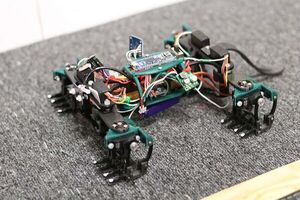
Robot lizard can quickly climb a wall just like the real thing
"Consider the lizard. Those that climb need to be both fast and stable to avoid predation and find food. A robot made to mimic their movements has shown how the rotation of their legs and the speed at which they move up vertical surfaces helps them climb efficiently. “Most lizards look a lot like other lizards,” says Christofer Clemente at the University of the Sunshine Coast, Australia. To find out why, Clemente and his team built a robot based on a lizard’s body to explore its efficiency. It is about 24 centimetres long, and its legs and feet were programmed to mimic the gait of climbing lizards." [...]
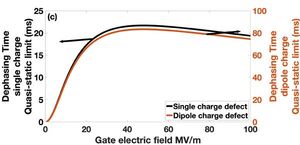
Qubits Comprised Of Holes Could Be The Trick To Build Faster, Larger Quantum Computers
"A new study indicates holes the solution to operational speed/coherence trade-off, potential scaling up of qubits to a mini-quantum computer. Quantum computers are predicted to be much more powerful and functional than today’s ‘classical’ computers. One way to make a quantum bit is to use the ‘spin’ of an electron, which can point either up or down. To make quantum computers as fast and power-efficient as possible we would like to operate them using only electric fields, which are applied using ordinary electrodes. Although spin does not ordinarily ‘talk’ to electric fields, in some materials spins can interact with electric fields indirectly, and these are some of the hottest materials currently studied in quantum computing. The interaction that enables spins to talk to electric fields is called the spin-orbit interaction, and is traced all the way back to Einstein’s theory of relativity." [...]

Researchers at U of T and LG develop ‘explainable’ artificial intelligence algorithm
"Researchers from the University of Toronto and LG AI Research have developed an “explainable” artificial intelligence (XAI) algorithm that can help identify and eliminate defects in display screens. The new algorithm, which outperformed comparable approaches on industry benchmarks, was developed through an ongoing AI research collaboration between LG and U of T that was expanded in 2019 with a focus on AI applications for businesses. Researchers say the XAI algorithm could potentially be applied in other fields that require a window into how machine learning makes its decisions, including the interpretation of data from medical scans. “Explainability and interpretability are about meeting the quality standards we set for ourselves as engineers and are demanded by the end user,” says Kostas Plataniotis, a professor in the Edward S. Rogers Sr. department of electrical and computer engineering in the Faculty of Applied Science & Engineering. “With XAI, there’s no ‘one size fits all.’ You have to ask whom you’re developing it for. Is it for another machine learning developer?" [...]

Scientists At Cern Successfully Laser-cool Antimatter For The First Time
"Swansea University physicists, as leading members of the ALPHA collaboration at CERN, have demonstrated laser cooling of antihydrogen atoms for the first time. The groundbreaking achievement produces colder antimatter than ever before and enables an entirely new class of experiments, helping scientists learn more about antimatter in future. In a paper published today in Nature, the collaboration reports that the temperature of antihydrogen atoms trapped inside a magnetic bottle is reduced when the atoms scatter light from an ultraviolet laser beam, slowing the atoms down and reducing the space they occupy in the bottle — both vital aspects of future more detailed studies of the properties of antimatter. In addition to showing that the energy of the antihydrogen atoms was decreased, the physicists also found a reduction in the range of wavelengths that the cold atoms can absorb or emit light on, so the spectral line (or colour band) is narrowed due to the reduced motion. This latter effect is of particular interest, as it will allow a more precise determination of the spectrum which in turn reveals the internal structure of the antihydrogen atoms. Antimatter is a necessity in the most successful quantum mechanical models of particle physics." [...]

Searching for the unknown
"Count all the known kinds of particles in the universe. Now double it. This is the promise of a family of theoretical models known as Supersymmetry, or SUSY for short. The notion of theories predicting a doubling of observed particles may not be as bizarre as it seems. In fact, it has historical precedent with the story of antimatter. “The first hints of antimatter came from Paul Dirac trying to solve problems in relativistic quantum mechanics,” says Laura Jeanty, who co-leads the Supersymmetry (SUSY) group on the ATLAS experiment at the Large Hadron Collider." [...]
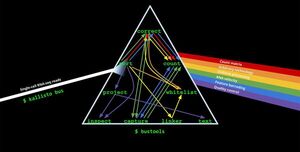
A Swiss Army Knife for Genomic Data
"A good way to find out what a cell is doing—whether it is growing out of control as in cancers, or is under the control of an invading virus, or is simply going about the routine business of a healthy cell—is to look at its gene expression. Though a vast majority of cells in an organism all contain the same genes, how those genes are expressed is what gives rise to different cell types—the difference between a muscle cell and a neuron, for example. In the last decade, technologies to measure gene expression in individual cells have revolutionized biology. No longer do biologists need to average out gene expression over many cells within tissues; now they can detect which genes are active in each cell at any time. Computational power has struggled to keep up with this explosion of data, however. For example, a single experiment can look at 100,000 cells and measure information from hundreds of thousands of transcripts (fragments of RNA produced when a gene is active), resulting in tens of billions of sequenced fragments." [...]

Designing Selective Membranes for Batteries Using a Drug Discovery Toolbox
"By binding specific ions in specially designed cages within its pores, a new membrane could enable more efficient flows in energy storage devices Membranes that allow certain molecules to quickly pass through while blocking others are key enablers for energy technologies from batteries and fuel cells to resource refinement and water purification. For example, membranes in a battery separating the two terminals help to prevent short circuits, while also allowing the transport of charged particles, or ions, needed to maintain the flow of electricity. The most selective membranes – those with very specific criteria for what may pass through – suffer from low permeability for the working ion in the battery, which limits the battery’s power and energy efficiency. To overcome trade-offs between membrane selectivity and permeability, researchers are developing ways to increase the solubility and mobility of ions within the membrane, therefore allowing a higher number of them to transit through the membrane more rapidly. Doing so could improve the performance of batteries and other energy technologies. Now, as reported today in the journal Nature, researchers have designed a polymer membrane with molecular cages built into its pores that hold positively charged ions from a lithium salt." [...]

Study shows promise of quantum computing using factory-made silicon chips
"A single qubit on a standard silicon transistor chip has been successfully demonstrated as “quantum capable” in a new study by the UCL spinout Quantum Motion, led by researchers at UCL and Oxford University. The qubit is the building block of quantum computing, analogous to the bit in classical computers. To perform error-free calculations, quantum computers of the future are likely to need at least millions of qubits. The latest study, published in the journal PRX Quantum, suggests that these computers could be made with industrial-grade silicon chips using existing manufacturing processes, instead of adopting new manufacturing processes or even newly discovered particles. For the study, researchers were able to isolate and measure the quantum state of a single electron (the qubit) in a silicon transistor manufactured using a ‘CMOS’ technology similar to that used to make chips in computer processors. Furthermore, the spin of the electron was found to remain stable for a period of up to nine seconds." [...]

New 3D microbatteries stand up to industry standard thin-film counterparts
"The thin-film lithium-ion batteries used in microdevices such as portable and medical electronics may supply a good amount of power relative to their mass, but do not provide enough power for many devices due to their limited size. Researchers have introduced a fabrication process that builds microbatteries with thick, 3D electrodes using lithography and electrodeposition – and seals each unit in a gel electrolyte-filled package. The new prototype shows the highest peak power density of any reported microbatteries, the researchers said. The new study, led by University of Illinois Urbana-Champaign postdoctoral researcher Pengcheng Sun and materials science and engineering professor Paul Braun, is published in the journal Advanced Materials. Most microbatteries have very thin, flat anodes and cathodes, which are great for saving space but do not pack the punch needed for the wireless transmission needs of today’s technologies, the researchers said. “The answer might seem to be to use thicker electrodes, which could hold more energy on a confined footprint, but that alone will only increase the pathway that ions and electrons must travel, cutting down on power,” Sun said." [...]
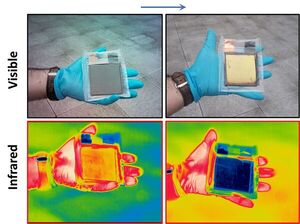
Graphene 'smart surfaces' now tunable for visible spectrum
"Researchers at The University of Manchester’s National Graphene Institute have created optical devices with a unique range of tunability, covering the entire electromagnetic spectrum, including visible light. A paper published in Nature Photonics outlines applications for this ‘smart surface’ technology range from next-generation display devices to dynamic thermal blankets for satellites and multi-spectral adaptive camouflage. The devices’ tunability is achieved by a process known as electro-intercalation, which in this case involves lithium ions being interposed between sheets of multilayer graphene (MLG), offering control over electrical, thermal and magnetic properties. The MLG device is laminated and vacuum-sealed in a low-density polyethylene pouch that has over 90% optical transparency from visible light to microwave radiation. Charge turns grey to gold During charge (intercalation) or discharge (de-intercalation), the electrical and optical properties of MLG change dramatically. The discharged device appears dark grey owing to the high absorptivity (>80%) of the top graphene layer in the visible regime." [...]
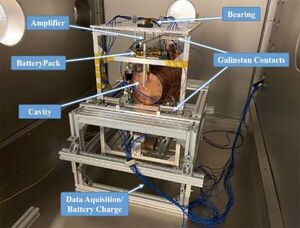
Latest EmDrive tests at Dresden University shows “impossible Engine” does not develop any thrust
"Dresden (Germany) – After tests in NASA laboratories had initially stirred up hope that the so-called EmDrive could represent a revolutionary, fuel-free alternative to space propulsion, the sobering final reports on the results of intensive tests and analyzes of three EmDrive variants by physicists at the Dresden University of Technology (TU Dresden) are now available. Grenzwissenschaft-Aktuell.de (GreWi) has exclusively interviewed the head of studies Prof. Dr. Martin Tajmar about the results. As the team led by Prof. Tajmar reported last weekend at the “Space Propulsion Conference 2020 + 1” (which was postponed due to the Corona pandemic) and published in three accompanying papers in the “Proceedings of Space Propulsion Conference 2020 + 1” (Paper 1, Paper 2, Paper 3), they had to confirm the previously discussed interim results, according to which the EmDrive does not develop the thrust previously observed by other teams (such as NASA’s Eagleworks and others). The team also confirmed that the already measured thrust forces can be explained by external effects, as they have now been proven by Tajmar and colleagues using a highly sensitive experimental and measurement setup. On their work on the classical EmDrive Prof. Tajmar reports to GreWi-editor Andreas Müller: “We found out that the cause of the ‘thrust’ was a thermal effect. For our tests, we used NASAs EmDrive configuration from White et al." [...]

A New Material Enables the Usage of "Calcium" for Batteries
"Scientists from Tohoku University have developed a new fluorine-free calcium (Ca) electrolyte based on a hydrogen (monocarborane) cluster that could potentially realize rechargeable Ca batteries. The researchers say the new material, achieved by designing the coordination structure of Ca cation with a weakly coordinating anion and mixed solvents, shows markedly improved electrochemical performances such as high conductivity and high electrochemical stabilities. Current lithium-ion (Li-ion) batteries have some drawbacks. They are approaching their demand limits of theoretical energy density and cost, and lithium is not naturally plentiful. Calcium, however, is the fifth most abundant element in Earth's crust and its metal anode has low reduction potential (-2.87 V vs. standard hydrogen electrode (SHE)) and volumetric capacities of 2072 mAh cm-3, giving it comparable cell voltage and energy density to those of Li. Calcium batteries are therefore cost effective and possess high battery performance, making them a suitable substitute for Li-batteries." [...]
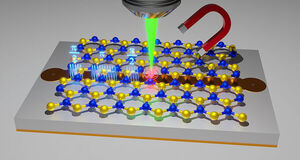
Spin Defects Under Control
"An international research team has made progress towards improved materials for quantum sensor technology. Medicine, navigation and IT could benefit from this in the future. Boron nitride is a technologically interesting material because it is very compatible with other two-dimensional crystalline structures. It therefore opens up pathways to artificial heterostructures or electronic devices built on them with fundamentally new properties. About a year ago, a team from the Institute of Physics at Julius-Maximilians-Universität (JMU) Würzburg in Bavaria, Germany, succeeded in creating spin defects, also known as qubits, in a layered crystal of boron nitride and identifying them experimentally. Recently, the team led by Professor Vladimir Dyakonov, his PhD student Andreas Gottscholl and group leader PD Dr. Andreas Sperlich, succeeded in taking an important next step: the coherent control of such spin defects, and that even at room temperature." [...]

Thermal Power Nanogenerator Created Without Solid Moving Parts
"As environmental and energy crises become increasingly more common occurrences around the world, a thermal energy harvester capable of converting abundant thermal energy — such as solar radiation, waste heat, combustion of biomass, or geothermal energy — into mechanical energy appears to be a promising energy strategy to mitigate many crises. The majority of thermal power generation technologies involve solid moving parts, which can reduce their reliability and lead to frequent maintenance. This inspired researchers in China to develop a thermal power nanogenerator without solid moving parts. In Applied Physics Letters, from AIP Publishing, the researchers propose a thermal power nanogenerator, called a thermoacoustically driven liquid-metal-based triboelectric nanogenerator, or TA-LM-TENG, which converts thermal energy into electrical energy. “This generator includes two parts: a thermoacoustic engine and a liquid-metal-based triboelectric nanogenerator (LM-TENG),” said Guoyao Yu, a professor at the Technical Institute of Physics and Chemistry, Chinese Academy of Sciences. First, the thermoacoustic engine converts thermal energy into acoustic energy via oscillatory thermal expansion and contraction of a gas." [...]

New computing algorithms expand the boundaries of a quantum future
"Quantum computing promises to harness the strange properties of quantum mechanics in machines that will outperform even the most powerful supercomputers of today. But the extent of their application, it turns out, isn’t entirely clear. To fully realize the potential of quantum computing, scientists must start with the basics: developing step-by-step procedures, or algorithms, for quantum computers to perform simple tasks, like the factoring of a number. These simple algorithms can then be used as building blocks for more complicated calculations. Prasanth Shyamsundar, a postdoctoral research associate at the Department of Energy’s Fermilab Quantum Institute, has done just that. In a preprint paper released in February, he announced two new algorithms that build upon existing work in the field to further diversify the types of problems quantum computers can solve." [...]

The muon's magnetic moment fits just fine
"An extensive new calculation of the strength of the magnetic field around the muon — a sub-atomic particle similar to, but heavier than, an electron — closes the gap between theory and experimental measurements, bringing it in line with the standard model that has guided particle physics for decades. A paper describing the research by an international team of scientists appears April 8 in the journal Nature. Twenty years ago, in an experiment at Brookhaven National Laboratory, physicists detected what seemed to be a discrepancy between measurements of the muon’s “magnetic moment” — the strength of its magnetic field — and theoretical calculations of what that measurement should be, raising the tantalizing possibility of physical particles or forces as yet undiscovered. The new finding shrinks this discrepancy, suggesting that the muon’s magnetism is likely not mysterious at all. To achieve this result, instead of relying on experimental data, researchers simulated every aspect of their calculations from the ground up — a task requiring massive supercomputing power. “Most of the phenomena in nature can be explained by what we call the ‘standard model’ of particle physics,” said Zoltan Fodor, professor of physics at Penn State and a leader of the research team." [...]
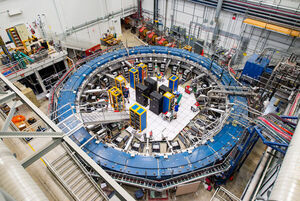
First results from Fermilab’s Muon g-2 experiment strengthen evidence of new physics
"The long-awaited first results from the Muon g-2 experiment at the U.S. Department of Energy’s Fermi National Accelerator Laboratory show fundamental particles called muons behaving in a way that is not predicted by scientists’ best theory, the Standard Model of particle physics. This landmark result, made with unprecedented precision, confirms a discrepancy that has been gnawing at researchers for decades. The strong evidence that muons deviate from the Standard Model calculation might hint at exciting new physics. Muons act as a window into the subatomic world and could be interacting with yet undiscovered particles or forces. “Today is an extraordinary day, long awaited not only by us but by the whole international physics community,” said Graziano Venanzoni, co-spokesperson of the Muon g-2 experiment and physicist at the Italian National Institute for Nuclear Physics. “A large amount of credit goes to our young researchers who, with their talent, ideas and enthusiasm, have allowed us to achieve this incredible result.” A muon is about 200 times as massive as its cousin, the electron." [...]
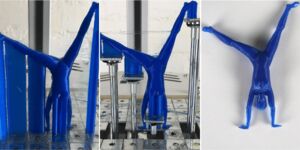
How a Moving Platform for 3-D Printing Can Cut Waste and Costs
"Researchers at USC Viterbi have developed a unique low-cost dynamically-controlled surface for 3-D printers that reduces waste and saves time. 3-D printing has the potential to revolutionize product design and manufacturing in a vast range of fields—from custom components for consumer products, to 3-D printed dental products and bone and medical implants that could save lives. However, the process also creates a large amount of expensive and unsustainable waste and takes a long time, making it difficult for 3-D printing to be implemented on a wide scale. Each time a 3-D printer produces custom objects, especially unusually-shaped products, it also needs to print supports–printed stands that balance the object as the printer creates layer by layer, helping maintain its shape integrity. However, these supports must be manually removed after printing, which requires finishing by hand and can result in shape inaccuracies or surface roughness. The materials the supports are made from often cannot be re-used, and so they’re discarded, contributing to the growing problem of 3-D printed waste material." [...]
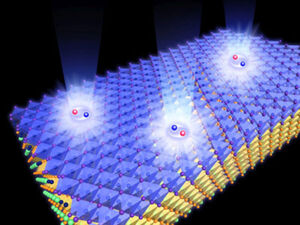
Thin cuprous iodide film will enable better optoelectronic devices
"A defect-free thin film of cuprous iodide—made up of just one crystal—has been fabricated by RIKEN physicists1. The atomically flat sample is a boost for producing better semiconductors. Semiconductors lie at the heart of many optoelectronic devices including lasers and light-emitting diodes (LEDs). Engineers would love to use cuprous iodide—an example of a halide compound—for semiconductors because it is an excellent conductor that is stable above room temperature. The trouble is that it is tough to fabricate a genuinely thin film of cuprous iodide without impurities. The usual method involves depositing the film from a solution." [...]

Skoltech scientists create a new electronegativity scale
"Skoltech chemists have proposed a new electronegativity scale and published their findings in Nature Communications. The concept of electronegativity introduced by Linus Pauling, a great American chemist, in the 1930s refers to the ability of an atom to attract electron density. In a chemical bond, the more electronegative atom gains extra electrons, becoming negatively charged, while the less electronegative one loses electrons and becomes positively charged. Electronegativity is a fundamental notion, essential for explaining things that range from the energy of chemical bonds to the (in)stability of chemical compounds and the color and hardness of crystals. Since then, chemists have come up with various definitions and scales of electronegativity. Yet Pauling’s scale is the first and the most common one, present in every chemistry textbook." [...]

Actor in a Supporting Role: Substrate Effects on 2D Layers
"Researchers detected non-negligible interactions between technologically intriguing 2D materials and the substrates that physically support them Atomically thin layers are of great technological interest because of potentially useful electronic properties that emerge as the layer thickness approaches the 2D limit. Such materials tend to form weak bonds outside the layer and are thus generally assumed to be unaffected by substrates that provide physical support. To make further progress, however, scientists must rigorously test this assumption, not only to better understand single-layer physics, but also because the existence of substrate effects raises the possibility of tuning layer properties by tweaking the substrate. As reported in the journal Physical Review Letters, a team led by Tai-Chang Chiang of the University of Illinois at Urbana-Champaign and his postdoctoral associate, Meng-Kai Lin, used Berkeley Lab’s Advanced Light Source (ALS) to probe changes in the electronic properties of a 2D semiconductor, titanium telluride, as the thickness of a substrate, platinum telluride, was increased. Single-layer titanium telluride is highly sensitive to what lies underneath, making it particularly useful as a test case for investigating substrate coupling effects. The results showed that as the substrate thickness increased, a dramatic and systematic variation occurred in the single-layer titanium telluride." [...]

Seeing Quadruple
"Machine-learning methods lead to discovery of rare "quadruply imaged quasars" that can help solve cosmological puzzles With the help of machine-learning techniques, a team of astronomers has discovered a dozen quasars that have been warped by a naturally occurring cosmic "lens" and split into four similar images. Quasars are extremely luminous cores of distant galaxies that are powered by supermassive black holes. Over the past four decades, astronomers had found about 50 of these "quadruply imaged quasars," or quads for short, which occur when the gravity of a massive galaxy that happens to sit in front of a quasar splits its single image into four. The latest study, which spanned only a year and a half, increases the number of known quads by about 25 percent and demonstrates the power of machine learning to assist astronomers in their search for these cosmic oddities. "The quads are gold mines for all sorts of questions. They can help determine the expansion rate of the universe, and help address other mysteries, such as dark matter and quasar 'central engines,'" says Daniel Stern, lead author of the new study and a research scientist at the Jet Propulsion Laboratory, which is managed by Caltech for NASA." [...]

The Spintronics Technology Revolution Could Be Just a Hopfion Away
"Pioneering study co-led by Berkeley Lab has significance for next-gen information technologies Adecade ago, the discovery of quasiparticles called magnetic skyrmions provided important new clues into how microscopic spin textures will enable spintronics, a new class of electronics that use the orientation of an electron’s spin rather than its charge to encode data. But although scientists have made big advances in this very young field, they still don’t fully understand how to design spintronics materials that would allow for ultrasmall, ultrafast, low-power devices. Skyrmions may seem promising, but scientists have long treated skyrmions as merely 2D objects. Recent studies, however, have suggested that 2D skyrmions could actually be the genesis of a 3D spin pattern called hopfions. But no one had been able to experimentally prove that magnetic hopfions exist on the nanoscale. Now, a team of researchers co-led by Berkeley Lab has reported in Nature Communications the first demonstration and observation of 3D hopfions emerging from skyrmions at the nanoscale (billionths of a meter) in a magnetic system." [...]

Giant radio pulses from pulsars are hundreds of times more energetic than previously believed
"A group led by scientists from the RIKEN Cluster for Pioneering Research, using coordinated observations of the Crab pulsar in a number of frequencies, have discovered that the “giant radio pulses” which it emits include an increase in x-ray emissions in addition to the radio and visible light emissions that had been previously observed. This finding, published in Science, implies that these pulses are hundreds of times more energetic than previously believed and could provide insights into the mysterious phenomenon of “fast radio bursts (FRBs).” Giant radio pulses—a phenomenon where extremely short, millisecond-duration pulses of radio waves are emitted—have been observed in association with a dozen pulsars in our Galaxy, but little is known about the mechanism that causes them. It has been proposed that they may also be the origin of “fast radio bursts”—rapid bursts of radio waves that are believed to originate from energetic events in the extragalactic universe. To gain insights into these phenomena, the RIKEN-led group made coordinated observations of the Crab pulsar, one of the most famous and well-observed pulsars. The explosion of this star in a supernova explosion was witnessed by Chinese and Japanese observers in the year 1054 and led to the formation of the beautiful Crab Nebula that can still be seen today. The group began looking to see if there was an increase in X-ray emissions associated with giant radio pulses." [...]

This Hydrogen Fuel Machine Could Be the Ultimate Guide to Self-Improvement
"Study co-led by Berkeley Lab uncovers secret behind humble material’s surprise performance as an artificial photosynthesis device Three years ago, scientists at the University of Michigan discovered an artificial photosynthesis device made of silicon and gallium nitride (Si/GaN) that harnesses sunlight into carbon-free hydrogen for fuel cells with twice the efficiency and stability of some previous technologies. Now, scientists at the Department of Energy’s (DOE’s) Lawrence Berkeley National Laboratory (Berkeley Lab) – in collaboration with the University of Michigan and Lawrence Livermore National Laboratory (LLNL) – have uncovered a surprising, self-improving property in Si/GaN that contributes to the material’s highly efficient and stable performance in converting light and water into carbon-free hydrogen. Their findings, reported in the journal Nature Materials, could help radically accelerate the commercialization of artificial photosynthesis technologies and hydrogen fuel cells. “Our discovery is a real game-changer,” said senior author Francesca Toma, a staff scientist in the Chemical Sciences Division at the Department of Energy’s Lawrence Berkeley National Laboratory (Berkeley Lab). Usually, materials in solar fuels systems degrade, become less stable and thus produce hydrogen less efficiently, she said. “But we discovered an unusual property in Si/GaN that somehow enables it to become more efficient and stable." [...]
Projetos Maker
Diversos Projetos interessantes.
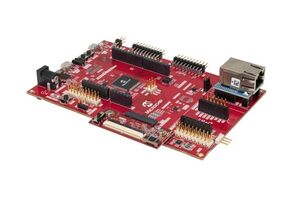
Keyword Spotting with the SAME54 Curiosity Ultra
"Perform keyword spotting on Microchip's SAME54 Curiosity Ultra with Edge Impulse. This tutorial will guide you through the process of setting up and running a pre-built keyword spotter on a SAME54 using a model developed with Edge Impulse. This tutorial includes the training data, trained model, and deployment code so you can get up and running quickly, but I’ll also be explaining how you can modify the project to develop your own keyword spotter. Before You Start Before we get started, you'll need to install and set up the required software as detailed in the steps below. 1. Install the MPLAB IPE tool (available with the MPLAB X installer tool) if you just want to flash the included HEX file." [...]
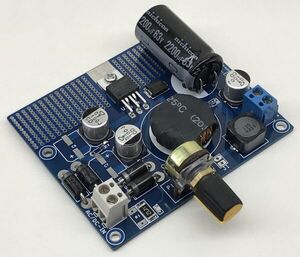
1.2V to 50V @ 3A – Adjustable Power Supply with 55Vdc Input
"The project presented here is a wide input voltage range non-isolated DC-DC Converter, that provides a regulated, adjustable output voltage. The operating input supply is 55V DC and output regulated from 1.2V to 50V DC. The project built using LM2576HVT-ADJ IC. Screw terminals provided for easy input and output connections, onboard power LED at the input, bridge rectifier for AC/DC Input, an onboard potentiometer to adjust the output voltage, etc. This is a low-profile board with a thermal area on PCB that acts as a heatsink. An additional LC filter using C5 and L2 that reduces the output ripple by a factor of 10 or more is included in this circuit." [...]

How to connect RPi Pico to WiFi and send phone notifications
"We show how to connect Pico to WiFi while maintaining low power and running it directly on AAA batteries In this project we show how to connect Raspberry Pi Picoto WiFi by using the Cricket WiFi moduleand send an alert to our phone. We also explain why using Cricketwill make the WiFi connectivity so power efficient that our device can last on single batteries for months or even years. This project can be realised by everyone who has some basic IT skills. We demonstrate step by step what needs to be done to put together a complete device. To keep it easy we write a simple Python program which flashes LED light every 5 minutes on the Picoboard. When the LED flashes it also instructs Cricketto send a notification to our phone." [...]
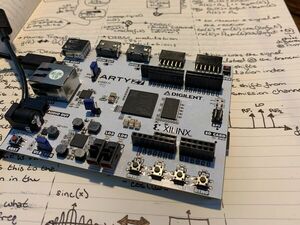
DSP for FPGA: Using Xilinx DDS with Custom FIR
"See how to integrate your custom FIR with Xilinx DSP IP such as their DDS Compiler IP. Continuing with my series of a practical example of implementing a simple FIR in custom RTL, my next step is to use my custom FIR RTL with Xilinx's DDS Compiler IP block, which will exercise the FIR in a way that any practical application in a larger project might. To fully validate my custom FIR Verilog module, I decided that using the DDS Compiler IP block to output a chirp signal that starts in the passband of my FIR (which currently contains coefficients for a low pass filter with a sample rate of 100Mbps) and increases until it ends in the FIR's stopband. " [...]
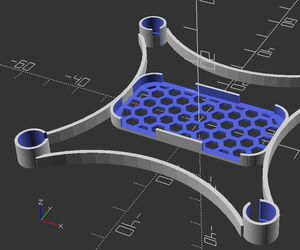
Micro Quadcopter in OpenSCAD
"3D printing (known in the industry as additive manufacturing) is a process of fabrication of a 3D object from a digital model. 3D printer prices have significantly dropped during past decade, so 3D printing is much more common nowadays. In this tutorial we will create a micro quadcopter frame to be 3D printed yourself. Supplies: CAD design and fabrication: OpenSCAD Access to an FDM printer Micro copter (optional): 3D printed frame F-1607 DC motors with propellers (4x) Flight controller + remote control 150 mAh LiPo battery" [...]
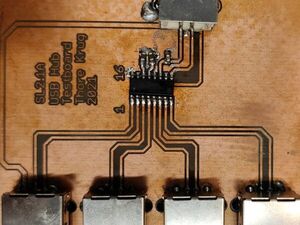
Hacker friendly USB hub
"Building a USB hub using a 30 cent IC which just requires a few passive components to function. USB hubs are a common Item for most makers/hackers, they expand the number of USB Ports which are available. You need more USB Ports for your project? Use a USB hub. While commercially available USB hubs are perfectly suited for most projects, sometimes you want to create a custom Board, this involves the designing of a PCB, many of the available ICs (Integrated Circuit) however are sold in a small SMD Package which makes them less accessible to the Standard maker. But this doesn't mean there are no options out there, many projects use the Fe1.1s as this IC is available in a SSOP28 which can be soldered with a bit of practice." [...]

2,400 LED Icosahedron (20 Sided)
"The major challenge of making a smaller LED cube in my opinion is the LED panels. Commercially available panels are designed for video walls and typically made at 64x64 pixel as a minimum size. This seems to be a good trade off between cost/complexity/light efficiency. On my previous project (https://gregdavill.com/blog/2020/6/13/miniature-3456x-led-cube) I had overcome one of the major hurdles of creating a smaller cube, because I had designed and built my own custom high density* LED panels. (*high density: less than 2.5 mm pixel pitch) So what next? I could make it smaller, improve the controller, improve the firmware." [...]

Sensorless FOC 3 Phase Low Power Brushless BLDC Motor Driver
"Driving a 3-phase brushless DC motor is very easy with this project. It is a simple and easy-to-build project that requires only a few external components. The circuit is based on AMT49400 IC which is an advanced 3-phase, Sensorless, brushless DC (BLDC) motor driver with integrated power MOSFETs. The chip includes the field-oriented control (FOC) algorithm which is fully integrated to achieve the best efficiency and acoustic noise performance. The motor speed is controlled by applying a duty cycle signal to the PWM input. Users may use Arduino, microcontroller, or discrete circuit to generate PWM for the speed controller." [...]

Arduino Snake LED Game
"In a previous project we created an interactive coffee table, which lit up leds under an object. In this project, we reuse that table to create a snake game from the 2D matrix of LEDs. If some parts of the project are unclear, it may be addressed in the previous project, so I recommend reviewing that for more information. Supplies: 1. ws2811 LED Bulbs 2. 5V Power Supply 3. Arduino I used the 2560 4." [...]
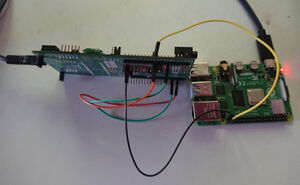
Software STM32 S/PDIF decoder
"Last time I moved, I set up my receiver and speakers across the room from my desk and computer. It's a pretty long (~20 feet) cable run. I was worried the audio quality would degrade over that distance, especially over my cheap cables. While that didn't end up being a issue, I considered a lot of possible solutions, like using differential signals, Bluetooth, PulseAudio, or S/PDIF. While I have no need for a S/PDIF decoder since the analog signal works just fine, the idea stuck rattled around in my head for a while. My STM32L476 Discovery board has an I2S DAC on it, but no hardware S/PDIF decoder, so I figured it would be fun to write a S/PDIF to I2S converter." [...]

On the phone monitor
"Working in a cubicle where colleagues couldn't see when I was on the phone, I needed a device that lights up every time I'm on the phone. I volunteer in an office where I'm often calling people on my personal cell phone, but others in the office can't see when I am, so sometimes try to talk with me over the partition or walk over to chat only to find I'm on a call. I needed something to alert them, so I made a simple device that lights up when I'm making or taking a phone call. 1) Wire the Arduino and Bluetooth module. 2) Upload the sketch to listen for Bluetooth notifications. 3) Upload the phone app to MIT AppInventor 2." [...]

Control sit/stand Desk height with a touch screen
"Control IKEA Bekant Desk sit/stand height with M5Stack Core2 using two Relay units and a ToF (time-of-flight sensor VL53L0x) unit. " [...]

555 Fizzle Loop Synth V4
"I've hit a pretty significant milestone with this Instructable - my 200th! It's been a busy 9 years, building and learning a lot of new skills whist producing these 200 'ibles - and it's been a blast. Thanks to everyone who has ever voted for me in a competition or given me some positive vibes - you guys make it all the more fun for me. For the 200th 'ible I present to you my latest synth - the 555 Fizzle Loop Synth. Some of you might recall that I have built and published a few other iterations of this synth but this one really takes it to another level! You can check out the other versions in the below links." [...]

Analog Knobs on Raspberry Pi 400 with CYBERDECK Hat
"Raspberry Pi single board computers are wonderful devices. They can do so many things, including interact with sensors, inputs, and outputs with their GPIO (general purpose Input/Output) pins -- however, analog input and output are not available on the stock Raspberry Pi. What happens when you want to turn some knobs or slide some faders? No fear, it's simple to add an Analog-to-Digital Converter (ADC) and this guide is going to show you how! You'll use the retro-tastic CYBERDECK Hat to add some STEMMA QT / Qwiic compatible I2C connectors to the Raspberry Pi 400, and then plug in the PCF8591 Quad 8-Bit ADC + DAC breakout board. The PCF8591 makes it simple to add four potentiometers to your Pi project." [...]

DehneEVSE - Open source EV charging station
"I designed and built my own EVSE EV Charging station from scratch because I wanted 2 stations with each 22kW support (3 phase, 400V, 32A) and "real-time" current & voltage measurements on all phases - in order to be able to do dynamic load sharing between the stations. E.g. if car-1 only uses 13A, the remaining 19A are allowed on the second station. It was a real full stack project, reaching from hardware/electronics design all the way to the frontend webapp written in TypeScript. Building your own charging stations is fun and gives you full control over the charging (assuming you like to code). It is also cheaper (see BOM below)." [...]
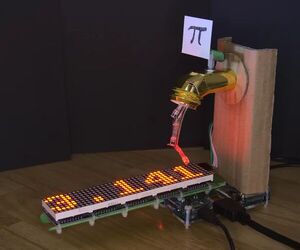
A Spigot That Streams Digits of Pi
"There are several methods for calculating the value of Pi. One approach that was devised by mathematicians (Gibbons, Rabinowitz, and Wagon) generates the digits iteratively one after the other using what is called a spigot algorithm. There are a number of implementations of spigot algorithms that will run on the Raspberry Pi. But wouldn't it be cool if you can control the spigot algorithms using a physical spigot from which each digit of Pi drips out? The following steps will describe how to dress up a Raspberry Pi to look like a shiny spigot from which the digits of Pi will be issued when opened. Supplies: Raspberry Pi A case for the Raspberry Pi - I used one from Pimoroni MAX7219 8x8 LED modules - I used 5 of these 3 LEDs 10K potentiometer 3x 150 ohm resistors 2x 1K ohm resistors 0.47 microfarad capacitor Perforated prototyping circuit board Male and female headers Wire Soldering equipment Cardboard - both single layer and corrugated Popsicle sticks Zip ties Glue" [...]
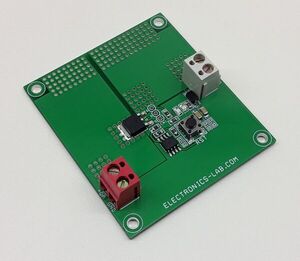
Low Voltage Lead Acid Battery Disconnect board – Prevents Deep Discharge Of 12V Lead Acid Battery
"This project helps to optimize the 12V lead-acid (SLA) battery life as it prevents the battery from going into deep discharge. It is very important to disconnect the load before the battery enters into deep discharge as this may destroy or damage the battery cells. The circuit shown here turns off the load before the battery enters deep discharge and avoids a further (deep) discharge that can shorten the SLA battery life. Once the battery is recharged or replaced you need to push a reset switch to power ON the load. The predetermined load level is set to 12V, this voltage level is proportional to the battery voltage which is determined by resistor divider R2, and R9. Once the voltage falls below the setpoint (12V) it disconnects the load, the load-battery connection remains open until the system receives a manual reset command using tactile switch SW1." [...]
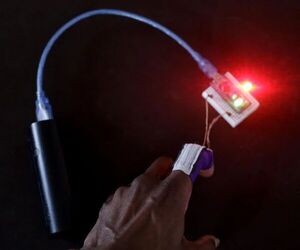
Finger Bend
"Finger Bend is a sensor created to find a way of making finger bends inside of a glove, control light and sound. The idea behind this glove is to then connect it to a body suit with other eTextile sensors for Immersive Audiovisual Performances. What inspired me to create this project was the vision of performing freely through body movements. It is our innate interface. From my view, it is the obvious tool, instead of a trackpad, mouse, tablet, controllers, joysticks Supplies:Materials: Stretch Piezoresistive Conductive Fabric Copper Thread Stretchy Jersey Fabric non-conductive thread Tools: Sewing machine LED Breadboard Computer with arduino and the library for the microcontroller* you are using if it is not yet installed USB cable Lighter or heat gun (for shrink tube) Examples of Microcontrollers: Arduino Uno / Nano / Teensy / ESP32" [...]

TClock - Tissue Box Clock
"In this Instructable I will show you how you can convert an empty tissue box into a cool Arduino based clock that can show the time, date, current temperature & humidity in the room. Supplies: Enclosure Supplies: Empty Tissue Box Utility Knife / Scissor Hot Glue Gun / Adhesive Electronics: 32x8 LED Matrix - for the clock display DS3231 RTC - for time related functionality DHT11 Temperature and Humidity Sensor - To measure internal temperature and humidity 10K Ohm Resistor - used as pull up resistor for DHT11 Arduino UNO ( I used the UNO but you should be able to use any Arduino/Arduino clone) - Brain of the project Breadboard Jumper Wires Laptop and Arduino IDE to program the code to Arduino Power Bank / 9V battery for power" [...]
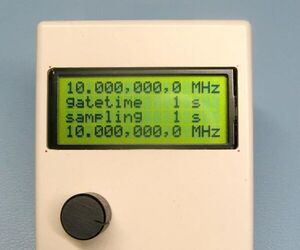
Frequency Counter With Variable Gate Time
"Frequency counter (reciprocal) Gate time selectable from 0.1 second up to 60 seconds Frequency range from 0.1 Hz up to 10 MHz (tested) Input 3.3V and 5V safe Uses a STM32F103C8 (Blue Pill) and 16x4 LCD Supplies: STM32F103C8 (Blue Pill) 16 x 4 LCD screen (HD44780 compatible) 10 MHz OCXO 74HC74 74HC00 3.3V voltage regulator rotary encoder with button some resistors, capacitors and diodes perfboard project box" [...]

Customizable Random Number Generator
"In this project, we will be building a "Customizable Random Number Generator," in which you can set the minimum and maximum values. We will be using two buttons to toggle the settings on the OLED display. For example, if the minimum value is 0 and our maximum value is 6 the random number generator will generate a number between those values such as 5. The components needed to make the project are: Arduino IDE Arduino Nano 0.96" SSD1306 128X64 OLED 2x Buttons Breadboard Jumper Wires" [...]

USB Real Time Clock for Raspberry Pi (USB RTC)
"MCP2221 USB-I2C Converter | DS3231 High-Precision RTC Chip | TCXO | Inbuilt-Temperature Sensor | Cross-Platform Compatibility We are aware that the hustle of their developers and hardware pros they face in their endeavours that redirect them to create numerous terrific gadgets. An individual should join the RTC module together with jumper wires, soldering procedures, or simply by using an outside PCB, also combined side it, programming must conduct RTC which creates the method complex, time taking as well as feverish. We created a technologically advanced level RTC apparatus’s RTC to get Raspberry-Pi “with the powerful integrated circuit DS3231 runs on non-power-consumptions using Integrated Temperature Compensated Crystal Oscillator. USB RTC to get Raspberry-Pi included ofMCP2221, also a USB-to-UART/I2C sequential converter, that empowers USB connectivity, even in the procedures which include a USB, UART (Serial), GPIO, and I2C interfaces which may run out of 6--8 ft about the single battery. USB Real Time Clock For Raspberry Pi You will find products such as Info Loggers, Digital clock, and Attendance platform, digicam, etc. who are very apparatus for everyday usage in the modern day world." [...]

High Side Switch with Input Overvoltage and Overcurrent Protection
"The project here is a 48V protected, high side switch designed to switch a 5A output load from input voltages from 8V to 48V. The circuit helps the user to easily ON/OFF the high current and voltage load with over-voltage lockout and over-current protection. The wide input range and low shutdown current (1μA typical) make it suitable for automotive, industrial, medical instruments, and telecom applications. This board offers a low 50ns (typical) propagation delay, fast switching times (<10ns), and 100% duty cycle operation. The project is based on LTC7000 which is a fast high voltage protected high side N-channel MOSFET driver. An internal charge pump fully enhances an external N-channel MOSFET switch, allowing it to remain on indefinitely." [...]
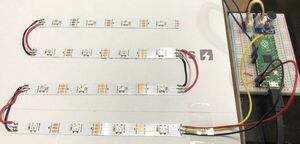
Raspberry Pi Pico: Sound activated RGB LED matrix
"A DIY RGB LED matrix which blinks in pattern with music or any sound. Overview This is a fun project to demonstrate programmable I/O hardware using PIO to control RGB LED (WS2812 Neopixels) movements activated by a connected sound sensor. What is PIO? Programmable I/O (PIO) is a new piece of hardware developed for RP2040 (the chip on the Raspberry Pi Pico). It allows us to create new types of hardware interfaces on Raspberry Pi Pico. Please refer to the blog post https://www.raspberrypi.org/blog/what-is-pio/ to know more about it. - Jumbo CNC Laser Etcher Designed With Autodesk Fusion 360 #CNC #3D-Printed #Stepper_Motor #Laser fr1yi7rkn36c8t8.png YT: bazL2gomHAM "With this Instructable, not only will you build the largest and lightest 7.5W Laser Etcher you've ever seen in action, you will emerge an engineering stallion with your honed Autodesk Fusion 360 skills." [...]
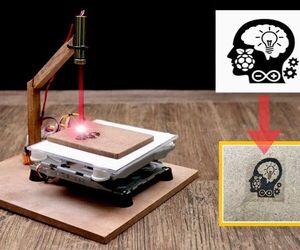
DiY Mini Laser Engraver Machine
"This is a very interesting project for any electronics hobbyist & Engineers . This engraver will be able to engrave cardboard, wood, vinyl stickers etc. visit DiY Projects Lab for More CNC machine i wish you liked it Supplies: Parts and Materials Required Arduino UNO (with USB cable) 2x DVD drive stepper mechanism 2x A4988 stepper motor driver modules (or CNC shield) 250mW Laser with adjustable lens 12v 2Amps power supply minimum 1x IRFZ44N N-CHANNEL Mosfet ,etc.. Tools List: Soldering Iron Drill Machine Metal File Sand paper Wire Cutter Superglue" [...]

ESP32 Walkie-Talkie
"It's a Walkie-Talkie based around the ESP32. It transmits audio using either UDP Broadcast or ESP-NOW. We've made a Walkie-Talkie using the ESP32. Audio data is transmitted over either UDP broadcast or ESP-NOW. So the Walkie-Talkie will even work without a WiFi network! I've based it around an I2S microphone and an I2S Amplifier - but it will work equally well with analogue microphones and headphones with a small change to the code." [...]
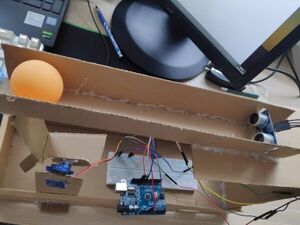
Self Balancing Ball and Beam using PID control
"By implementing PID control we have made the ball balance on the beam at the desired setpoint of 15 cms(total beam length = 30 cms) In this project PID control has been implemented to balance a ball in the center of the beam. There is a servo motor that has been used to provide the beam with 1 DOF and this helps us to move the ball on the beam to the desired setpoint. An error signal is generated and that has been fed to the controller and is then provided to the servo motor as an angle to move so that the ball balances in the middle.PID control stands for Proportional Integral and Derivative control, it's used not only in hobby projects but also in many industrial applications. " [...]

3W Stereo Differential Input CLASS-D Audio Amplifier with UP/DOWN Volume
"The circuit presented here is a 3W stereo audio amplifier with memory UP/DOWN volume control. The project is based on PAM8408 IC from Diode Incorp which is a filter-less class-D amplifier with high SNR and Differential input which helps eliminate noise. Two tactile switches are provided to control the UP/DOWN volume in 32-steps and it will hold the setting when the chip is in shutdown mode. The operating supply is 2.5V to 6V DC and this supply range helps to operate it with batteries like the use of 4 x Alkaline batteries. The small PCB size, 87% efficiency, low cost, minimum external components make this project ideal for portable applications. The PAM8408 also has built-in auto-recovery SCP (Short Circuit Protection) and thermal shutdown." [...]
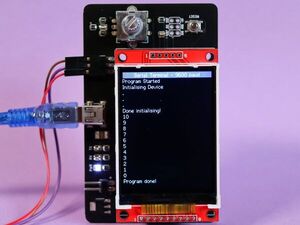
Serial Debugger With Display
"A pocket-sized debugger for monitoring serial data. Description Sometimes you need to quickly check the state of the device and having to use a computer for that can be a bit bothersome. A pocket-sized debugger that can monitor and display the data stream is the perfect solution for that! Details So how does it work? On the upper right corner, there's a pin header (RX, TX, GND) meant to be connected to the device you want to receive data from. The current iteration is only 5V tolerant, in the future we plan to add a switch to shift between the 5V and 3.3V logic levels." [...]

LED Snowboard with Motion-Reactive Animation
"Shred down the slopes this season with your own custom motion-reactive LED snowboard. This tutorial includes CircuitPython sample code with 8 different layered LED animation modes, plus a motion-sensitive carving mode that lights your active edge as you carve down the mountain. Learn to protect your electronics from the elements using waterproof enclosures and connectors. Make your board robust enough that you can ride all night long. " [...]
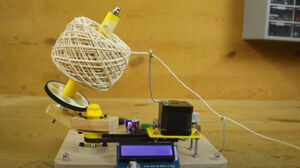
Building a DIY Arduino Yarn Ball Winding Machine
"Do you have a ton of yarn that needs winding into yarn balls? Perhaps you don't have the time, or just can't be bothered to do it by hand? Then why not make yourself an Arduino-powered yarn ball winding machine? Here's how... But first, you will need some parts and equipment before you get stuck in. Tools and parts needed - Arduino Nano - NEMA 17 stepper motor - A4988-stepper motor driver module - 1602 I2C LCD DISPLAY - 15/32 inch (12mm) thick wooden board - 5/16 inch (8mm) smooth shaft rod - 13/64 inch (5mm) threaded rods - 3D printed parts (CAD files here) - Rubber timing belts - 693 zz ball bearings - 13/64 inch (5mm) ID timing pulley - 5/16 inch (8mm) flange mount - Rotary knob - 5/16 inch (8mm) flange bearing - Rubber feet - Wood glue - 5/16 inch (8mm) pillow bearing - 13/64 inch (5mm) threaded rod - Soldering kit - Screwdriver set - Electrical wires, resistors, and soldering gear - Assorted PCB wire female connectors and male pins - A 3D printer, or ask a friend with one to help out - Various 3D parts - Custom PCB board - Jigsaw - Various bolts and nuts" [...]
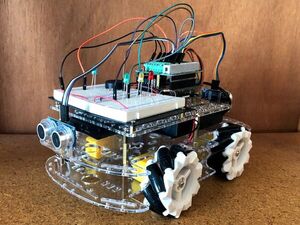
Arduino Omnidirectional Car
"Created an omnidirectional car that is powered by Arduino and controlled by a PS2 controller. Overview In this project I will be showing the process I used to build and control an omnidirectional car, utilizing mecanum wheels. The car will be controlled by a wireless PS2 controller and includes LEDs for speed indication, a small piezo horn, and HC-SR04 sensors for object detection. " [...]

Voice Loudness Monitor
"This product alerts the user when they are speaking too loudly via two LEDs. Louder voices spread more viral particles, so quieter is safer. In this pandemic it is important to take reasonable measures to reduce spreading viruses. A paper from 2019 found that louder voices spread more viruses (https://www.nature.com/articles/s41598-019-38808-z) [Asadi et al. 2019]. This simple project aims to remind people to not shout unnecessarily." [...]

Galvanic Isolated 8 Channel High-Side Switch (0.6A per channel)
"This project provides 8 fully protected and isolated high-side power switches that are able to handle current up to 625 mA. An 8-bit parallel microcontroller compatible interface allows connecting the inputs directly to a microcontroller or standalone circuit system. The input interface also supports direct control mode and is designed to operate with 3.3/5V CMOS compatible levels. The signal transfer from input to output side is realized by the integrated Coreless Transformer Technology. The board is designed for industrial applications such as process control and PLC to drive inductive, resistive, and capacitive loads like Relay, solenoid, lamps, heaters, piezo. The input can be driven by applying 3.3V/5V CMOS compatible signals to connector CN1." [...]
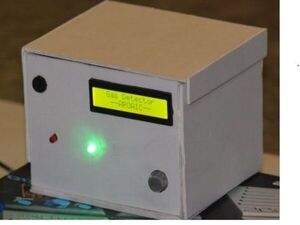
Gas leakage Detector system
"In case of gas leakage, buzzer gives alarm and the user will get a message on their phone. The LCD will be displaying gas value throughout. Gas leakage detection system, with SMS and sound alert. Has GSM module, buzzer and LED interfaced to Arduino Uno. In case of gas leakage, the buzzer starts giving alert, and red LED glows and the gas value is displayed on the LCD, and an SMS is sent to the user for alert. " [...]
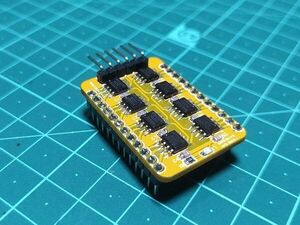
Individually Addresable Outputs
"Control multiple output devices using single GPIO pins from the microcontroller I was needed to control almost 200+ relays using one microcontroller and during research I found out that best way to do it is by using a GPIO Expander module but I wanted to have some simpler solution which should be both small and compact. Now if you worked with addressable RGB LEDs or neopixels you already know that we can control lots of such LEDs by just using one output pin. There is a chip inside each of the LEDs which can control 3 outputs, Red, Green and Blue LED in this case. It reads the data coming from the microcontroller, set it's outputs according to the given instructions and pass the rest of the code to the next IC. This way we can daisy chained as many of them as we want. I just wanted to impliment the same principle for any output devices in general, such as relays, to control even bigger loads." [...]

Serial Monitor With ILI9341 and BluePill
"Serial (ascii) monitor with 9 lines of 28 char. Baudrate from 2400 up to 256000 baud. Digital 3.3V or 5V input. Powered by a single Lithium-Ion battery. (3.7V nominal) Supplies: ILI9341 display (here a parallel version is used) BluePill (or other board with a STM32F103C8) 74HC14 (hex invering schmitt trigger) 3.3V low dropout voltage regulator rotary encoder (with or without button) lithium ion battery (e.g. from old telephone) some capacitors and resistors power switch project box PCB (perfboard)" [...]

DIY Arduino Audio Modulated (misical) Tesla Coil
"A Tesla coil is an electrical resonant transformer circuit designed by inventor Nikola Tesla in 1891. It is used to produce high-voltage, low-current, high frequency alternating-current electricity. The source of the audio signal in this case is the Arduino nano microcontroller. For this purpose, a simple codes are presented that generates a certain melody at output 9 of the microcontroller. This signal is now fed to the input of the modulator and next to the Cathode of the Vacuum Tube. " [...]

Pico Phone
"Send text messages using the Raspberry Pi Pico and a cellular notecard from Blues How does it work? The Pico Phone consists of the following basic components (check out the components section): Raspberry Pi Pico Notecard Sparkfun Qwiic Keypad Whenever someone enters their phone number followed by '#', the Pico transmits the phone number to the notecard. The notecard triggers a webhook. Using Twilio and Losant and the Dad Jokes API, a joke is texted to your phone number! In case you are not familiar with the Notecard, we recommend checking out this article. " [...]

Simple Indoor Air Quality Monitor
"The following instructable explains how to build a simple indoor air quality monitor. Through this monitoring you can better organize the ventilation in your rooms. And thus improve health and prevent mold. The following measured variables are displayed: VOC Index (based on a evaluation algorithm from Sensirion) Relative humidity [%] Temperature [°C] Pressure [mbar] It doesnt show the CO2 and the PM2.5 values, which are also interesting to validate the air quality. A CO2 sensor is of interest if the concentration of aerosols, and thus indirectly the risk of infection with COVID-19, is to be determined. With the presented measurement setup, a tendency can also be determined." [...]

Series, Parallel, Kirchhoff
"A network of resistors behaves as a single resistor: the current through the network is proportional to the potential difference applied. Calculating the equivalent resistance of a network starts for many at high school but may come back later with more complex cases also at university. For success in science and engineering it is crucial to be skilled in these calculations but also to develop an intuition on how to make quick approximate solutions. Being an expert in handling electrical resistance networks will come into great use for other types of networks that have similar behaviour: magnetic circuits, fluid dynamics, heat conduction, traffic flow, just to name a few. To hear is to forget, to see is to remember, and to do is to understand, so let’s practice resistor networks hands-on! This tutorial is great for the class-room, since it can be performed by students individually or in small groups: the equipment is cheap and common (a multimeter and some crocodile clips) and the consumables are very cheap (7 resistors per experiment - they cost less than a cent each when bought in 100-packs) - The students can keep the final resistor network as a souvenir." [...]
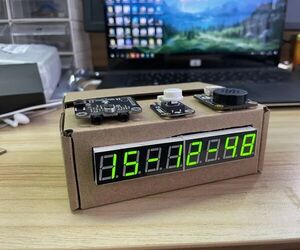
Making a Alarm Clock That Asks Questions Randomly
"Do you usually have trouble getting up? Set more than a dozen alarm clocks in the morning, but still can't wake up and turn them off in a daze. When you waking up and find out that you are late, and then you blame the alarm clock for not making any noise. In order to help me better complete my 996 workdays, a simple small alarm clock is specially made - an alarm clock that will randomly ask questions. Its unpleasant cry makes you sleepless; in addition, during the answering process, you must concentrate on listening to the question, otherwise, you will not be able to judge whether it is asking how many is one plus one or How many words in the question of how many is one plus one It is a home essential product, the initiator who forced you to the peak of life. Supplies: - Arduino UNO 1 - IO Expansion Board 1 - Speech Recognition 1 - Speech Synthesis Module 1 - DS3231M MEMS Precise RTC 1 - 7.4V Lipo 2500mAh Battery 1 - Digital Push Button (White) 1 - 8-Digital LED Segment Display Module 1 - I2C HUB 1 - Stereo Enclosed Speaker - 3W 8" [...]
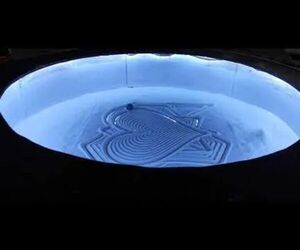
Zen Table
"Hello everyone, I got inspired by this genius I saw the video but I wasnt going to disarm one of my printers, so I developed new pieces and made all the procees to make my own version, I called "Zen Table" it is a long project and a little bit expensive, so be ready to work hard. Supplies:as general review, in this project you will need: a 3D Printer knowledge about digital circuits knowledge about cnc machines great ability with mechanisms These are the needed pieces for the electric part of the project Shield Ramps 1.4 - 1 piece LCD module for ramps 1.4 with module for shield SD "RepRapDiscount Smart Controller" 1 piece Drivers for step motor drv8825 3 pieces Jumpers for drivers 9 pieces Arduino mega 1 piece Nema 17 Motor Steps 17hs4023 0.7amp 1.4kg/cm 3 pieces 12v source 10 amps 1 piece LED strip 3 meters End-of-run switches (limit switches) 2 pieces Electric cable the amount depends on the distance from the table to plug" [...]

4x4x4 Led Cube Making
"What we are going to do here today is how to make a cool LED cube at low cost A LED cube allows us to create images and patterns by using the concept of an optical phenomenon known as persistence of vision (POV).The cube has 64 blue LEDs that make up its 4 layers (positives) and 16 columns (negatives). " [...]

How to use GSM For SMS Send Receive and Call
"How to use GSM For SMS Send Receive and Call with Arduino and GSM Module | GSM based Project" [...]
Secção Videos
Videos interessantes.

CONNECTORS -- The Secret Life of Components, a series of guides for makers and designers - Episode 6
That's all Folks!



